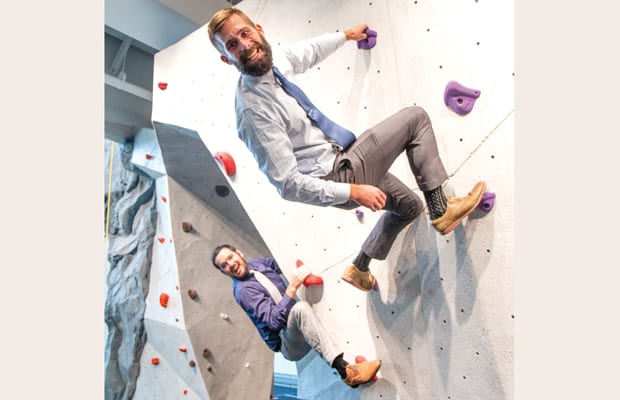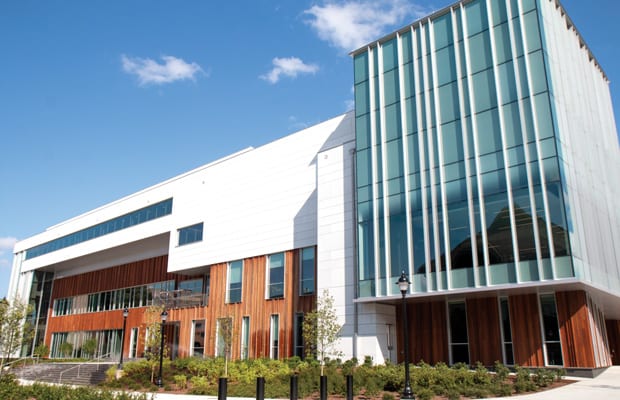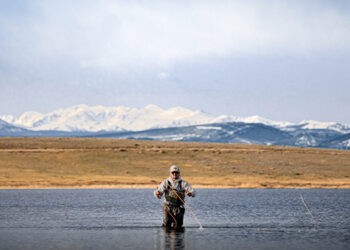Busting at the seams is how to describe the University of Connecticut’s (UConn) old recreation center.
At 29,000 square feet, it is dwarfed by the 191,000-square-foot center that has replaced it. Opened in August 2019, it was a four-year project that has led to a complete transformation of operations, services and impact for UConn Recreation.
Cyndi Costanzo, the executive director, and Jay Frain, the director, have been deep in the project. “Transformative” is the word both used to describe it, with a heavy focus on two very specific themes: creating connection and maximizing service.
“What we heard repeatedly over the years leading to design was our students at UConn were over programmed and suffering from a lack of connection to the university,” said Costanzo. “The open design welcomes people into the building, immediately exposes them to numerous options for participation, and breaks down physical barriers connecting people.”
One highlight of the new space is its mind/body studio. Going from two group fitness studios in the old building — one a converted racquetball court — to five is a big jump, but the mind/body studio is something else. It has an inlaid wood ceiling, pendulum lights, bamboo wood floor and a 15-by-10-foot glass bi-fold garage door that opens up onto an expansive terrace. Costanzo said the studio allows for them to connect to the outdoors, speaks to the aspect of well-being for students, and is even a space for them to host functions and events.

For Frain, the new outdoor adventure area is a highlight. With 5,000 square feet and looking like the inside of a lodge, he said it’s a far cry from the closet-like space it once was in. “I look at that space and think about where we have come from to where we’re going and I’m really excited about the future of where we’re going to continue to grow within that space,” he said.
But one of the most extraordinary things about UConn’s new recreation building isn’t what most people will see. Instead, it’s what they hopefully never will: a backend network of pathways for staff.
Frain painted the picture: It snows in the winter at UConn. Someone shovels the front area, but the snow is coming down hard. It’ll definitely need to be shoveled again, so instead of dragging the shovel to the back of the building, it would be found propped against the wall in the foyer. It broke the illusion of a place where students could come to destress, to get away from reality for a minute.
With that in mind, UConn has borrowed a bit of magic from Disney. Throughout the new center, you’ll find a back-of-the-house network that allows staff to move from the first to the third floor without being seen. Costanzo said employees are able to cart laundry, towels and fitness equipment, all without setting foot on the main floor. “We borrowed liberally from the Disney concept of being ‘behind the curtains’ and built egress paths for our team to move throughout the back of the house without disturbing our patrons’ experience,” she explained.
Because it’s ultimately all about the student experience. The central areas on each floor and detailed wayfinding allows for students to move about the space easily, and to locate staff if necessary. Plus, the open areas decrease the staffing needs, meaning savings that go into additional programming and services offered.
“It’s very easy for students to stay connected with us and be able to seek out that kind of assistance if they should need it,” said Frain. “We really like that idea of leveraging those open areas and really using them dynamically to feel as if they are connected.”
Connected is a big term at UConn Recreation, and it has driven the idea of more than one program. In fact, Michael D’Alfonso, the associate director of programming, explained in 2016 conversations within student affairs work teams, and counseling and mental health, led to requests dealing with connection. “[We were tasked] to develop programming to directly target the rising trends of anxiety and loneliness among college students,” said D’Alfonso. “We knew we needed to find ways for students to ‘digitally detox’ as well as engage in physical activity and also try something challenging.”
It seemed UConn Outdoors was the perfect fit, and the Challenge and Connect Retreat (C2) was born. Partnering with the student health and wellness department, the outdoor adventure team lead a three-day retreat to The Berkshires. There, students hike, have silent reflection and journaling time, do yoga and whitewater rafting, take communal meals, and participate in creative activities.
In its fourth year, the response has been positive from students and the campus community. Austin Darley, the coordinator for outdoor programs and the climbing center, has run the program over the past three years. He said it’s effective in helping students remove distractions, and much of its success comes from challenging students in different ways they often don’t anticipate.
But, he noted in a program like this one connection is best when not forced. “My advice for other rec professionals running a program such as C2, or really any outdoor program, is to try to not force that engagement too much and just let it naturally happen,” said Darley. “Don’t take for granted those downtimes when you are cleaning up from dinner or just sitting around the fire to share and listen.”
However, C2 had a limited reach and capacity with just the weekend retreat. As such, D’Alfonso said other events have sprung up that still embody the retreat’s mission. From full moon and sunset hikes, to snowshoe trips and a yoga/mindfulness retreat, they try to have plenty of offerings. In fact, the annual Sunset Yoga event has become a UConn tradition, attracting upwards of 700 participants and acting as an anchor program for opening week on campus. D’Alfonso noted the new climbing center and mind/body studio both provide even more options for programming.
To run programs with such success as C2, however, it means you have to have a great team behind it all. And Costanzo said it best: “We are the experts in this field, and our professionals, they take pride in our work. They have a great understanding of what their expertise is,” she said.
Frain noted their team’s “blue collar” mentality is exceptional. “We view our ability to plan, mobilize and execute outstanding programming as a key to what makes us a successful recreation department,” he noted. “Our team is always willing to do the little or unheralded things, many times in the background or in support of collaborative partnerships, that ensure the program is ultimately successful in meeting the needs of our participants.”
The 36-year tradition known as OOZeball — a one-day mud volleyball tournament that draws about 3,000 students — is just one example. UConn Recreation took it over and reduced the operation cost, environmental impact, injuries, etc. It’s all because the staff is willing to get knee deep in the mud, quite literally, and go beyond the job description.
In fact, like the new UConn rec center, the magic of campus rec at the university doesn’t happen on the surface. It’s in the unheralded small acts of the entire team. It’s the pounding of the pavement to build partnerships, creating programs like C2. It’s the little things, like back-of-the-house pathways and connecting with students over a meal in the woods. It’s the hard work and the dirty work that creates the very real magic at UConn.
As Frain said, it’s with a focus on service and connecting students that the team works diligently in the background, doing what needs to be done to create an exceptional end product. He noted they are a lot like an iceberg: the tip is magical, but what lies beneath the surface is where the magic is created. That is UConn Recreation. “We oftentimes are the 90 percent under the water you don’t see,” said Frain.











